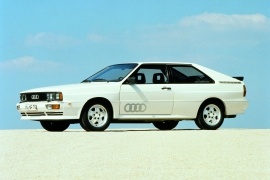AUDI Quattro Models/Series Timeline, Specifications & Photos
First production year: 1980
Engines: Gasoline
Body style: Coupé (two-door)
Audi unveiled the Quattro at the 1980 International Paris Motor Show, and the model became a legend in the rally world and among the German brand's fans.
When Audi decided to enter the world rally arena, it noticed that an all-wheel-drive system could give them an edge over its competitors. At those times, most rallies were held on gravel or snow-covered roads, and only a few races were held on tarmac. So it decided to give it a try and fitted a standard Audi 80 with a system that sent power in all corners. The next step was to install those underpinnings in the Coupe model. Thus, the Audi Quattro was born. And Quattro, which means four in Latin, became a respectable nameplate in the industry and was used by the German automaker on all of its vehicles fitted with an all-wheel-drive system.
It was the era of wedged shapes, and the Quattro couldn't be designed in any other way. Thus, at the front, the car sported four rectangular headlights that flanked the narrow grille fitted with horizontal slats where the automaker's badge took center stage. Underneath these, Audi installed a bumper that was extended downwards with an apron, which housed the fog lamps. From its profile, unlike the rest of the Coupe range, this version featured flared wheel arches, emphasizing the car's muscular look. The greenhouse was not very tall and featured large side windows. Despite the car's hatchback look, it was actually a three-box vehicle, where the trunk opened independently, and the rear windscreen was fixed. Another particular detail that made this version different than the rest of the Coupe range was the five-lug wheels.
Inside, the high-bolstered front seats provided excellent side support for the front occupants. The dashboard was also wedged-shaped, with a squarish instrument cluster that featured additional buttons mounted on its rim. On the center stack, the automaker placed specific buttons that locked the center and the rear differentials. But, despite being a car built in series production only to get a homologation number for rallying, it featured comfort amenities such as a stereo and power windows. Moreover, the rear seats were comfy enough for two adult-sized passengers.
Under the hood, Audi installed a 2.1-liter turbocharged gasoline engine with five inline cylinders. It sent the power through a five-speed manual gearbox in all corners. Thus, the Quattro proved that slippery conditions were no longer a problem for a regular car.
